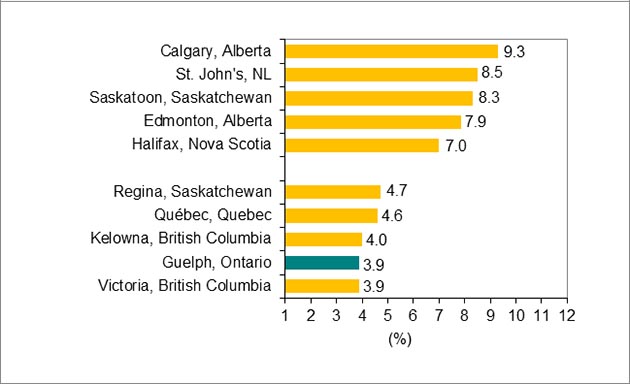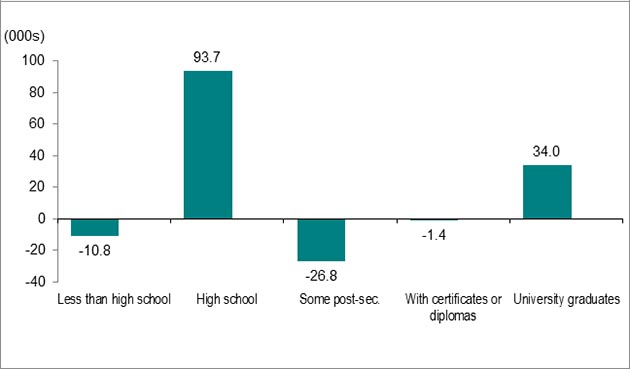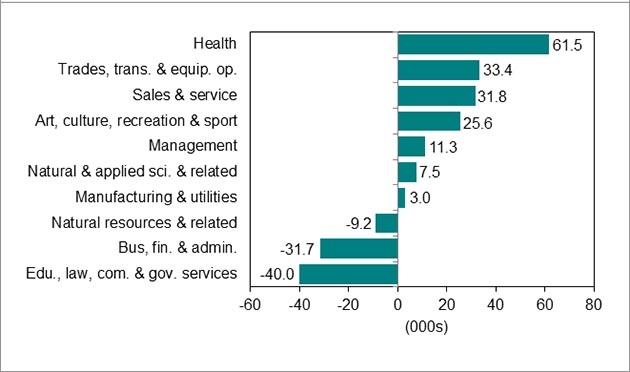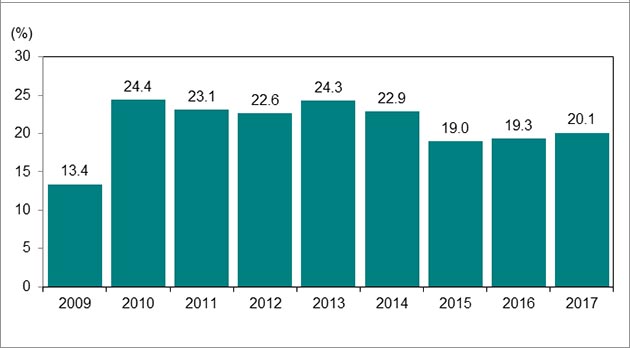Labour market report, May 2017
Employment in Ontario increased in May. Get the details in this report.
Quick facts
In May 2017, there were 11.7 million people in Ontario aged 15 years or older, 7.6 million, or 65%, were either working or actively looking for work. Of this population, 7.1 million were employed and 81% of them had a full-time job.
Ontario’s unemployment rate was 6.5%, with 489,700 people unemployed.
Employment increased in May
Chart 1 shows employment in Ontario from January 2012 to May 2017.

Source: Statistics Canada, Labour Force Survey, Table 282-0087, (seasonally adjusted data).
Employment in Ontario increased by 19,900 jobs in May, following a decrease of 1,600 jobs in April.
Full-time vs. part-time
The number of full-time jobs grew (10,000), as did part-time jobs (9,700).
Employment increase/decrease by age
Youth employment (ages 15 to 24 years) increased by 24,200 in May after increasing by 1,000 jobs in April.
People ages 25 to 54 years had job losses of 12,600, while those aged 55 and older had job gains of 8,400.
Employment in Canada rose by 54,500 jobs in May following an increase of 3,200 in April.
Unemployment rate increased to 6.5%
Chart 2 shows unemployment rates, Ontario and Canada, January 2012 to May 2017.

Source: Statistics Canada, Labour Force Survey, Table 282-0087, (seasonally adjusted data).
In May 2017, Ontario’s unemployment rate was 6.5%, up from 5.8% in April and Canada’s unemployment rate was 6.6%, up from 6.5% in April.
Compare this to January 2012 when Ontario’s unemployment rate was higher at 8.1%, and it was also higher for Canada, at 7.6%.
Rise in youth unemployment rate
The unemployment rate for youth increased to 13.2% in May, up from 12.2% in April.
Unemployment rate for adults
The unemployment rate for people ages 25 to 54 years increased to 5.5% in May, up from 5.0% in April.
For those aged 55 and older, the unemployment rate increased to 4.9%, from 4.2%.
Lowest and highest unemployment rates
Chart 3 shows census metropolitan areas (CMAs) with highest and lowest unemployment rates in Canada, May 2017.

Source: Statistics Canada, Labour Force Survey, Table 282-0135, (seasonally adjusted data to reduce volatility caused by small sample size).
Guelph, in southwestern Ontario, tied with Victoria, British Columbia for the lowest unemployment rate in Canada, at 3.9%.
Toronto and St. Catharines-Niagara were tied for the highest unemployment rate in Ontario in May, at 6.9%. (Not shown in the graph.)
Calgary recorded the highest unemployment rate nationally, at 9.3%, followed by St. John’s NL at 8.5%.
Other CMAs with the highest employment rates:
Saskatoon, Saskatchewan: 8.3%
Edmonton, Alberta: 7.9%
Halifax, Nova Scotia: 7.0%
Other CMAs with the lowest employment rates:
Regina, Saskatchewan: 4.7%
Québec, Quebec: 4.6%
Kelowna, British Columbia: 4.0%
Year-over-year comparisons
Chart 4 shows Ontario employment change by highest level of education, aged 25 and older, May 2016 and May 2017, year-to-date.

Source: Statistics Canada, Labour Force Survey, Table 282-0003, unadjusted data.
Employment increase and decrease by education level
In the first five months of 2017, employment in Ontario increased by an estimated 88,600 for adults 25 years and older compared to the first five months of 2016.
People with a high school level education gained the most jobs, with 93,700 net new jobs.
Individuals with a university degree had job gains of 34,000, while those with a postsecondary education (PSE) certificate or diploma lost 1,400 jobs.
People with less than high school education and those with some PSE recorded job losses of 10,800 and 26,800, respectively.
Unemployment rate by education level
The unemployment rate for adults 25 years and older with PSE credentials was 4.4% over the first five months of 2017, down from 4.9% a year earlier.
The unemployment rate for adults without PSE credentials was 7.2%, down from 7.7% a year earlier.
Employment increase and decrease by occupation
Chart 5 shows Ontario employment growth by occupation between May 2016 and May 2017, year-to-date.

Source: Statistics Canada, Labour Force Survey, Table 282-0041, unadjusted data.
Seven of the ten major occupational groups in Ontario recorded employment growth over the first five months of 2017 compared to a year earlier.
Learn more about the National Occupation Classification (NOC) system.
These occupations gained the most jobs:
- health (61,500)
- trades, transport and equipment operators and related (33,400)
- sales and service (31,800)
Other occupations that also gained jobs in May were:
- art, culture, recreation and sport (25,600)
- management (11,300)
- natural and applied sciences and related (7,500)
These occupations lost jobs:
- education, law and social, community and government services (40,000)
- business, finance and administration (31,700)
- natural resources, agriculture and related production occupations (9,200)
Long-term unemployment percentage increased
Chart 6 shows Ontario’s long-term unemployed as a percentage of total unemployment, May 2009 to May 2017, year-to-date.

Source: Statistics Canada, Labour Forces Survey, Table 282-0047, unadjusted data.
Over the first five months of 2017, an estimated 96,200 people were long-term unemployed, defined as being unemployed for 27 weeks or more. This was down from 99,000 in the first five months of 2016 and well above pre-recessionary levels.
Long-term unemployment share increased
Long-term unemployed individuals accounted for 20.1% of the total number of unemployed people in the first five months of 2017, higher than 19.3% a year earlier, and in the first five months of 2009, when it was 13.4%.
Average time in long-term unemployment
The average time in long-term unemployment increased to 20.1 weeks over the first five months of 2017 from 19.3 weeks a year earlier.